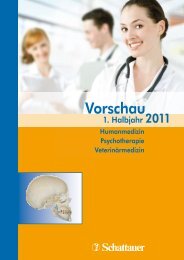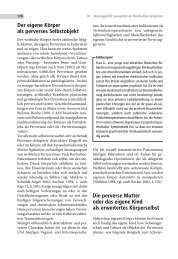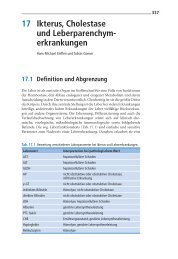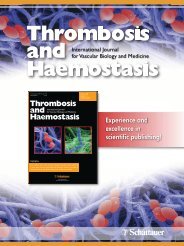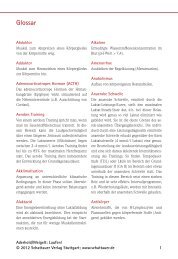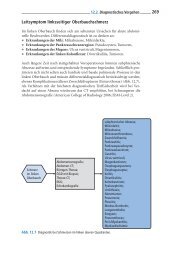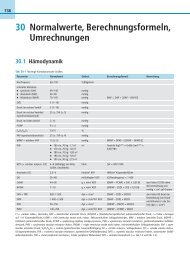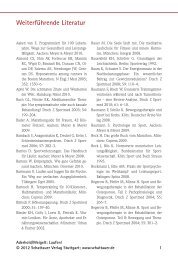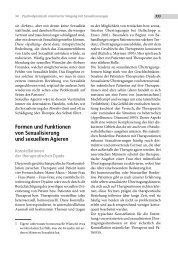DVO Guideline 2009 for Prevention, Diagnosis and Therapy of ...
DVO Guideline 2009 for Prevention, Diagnosis and Therapy of ...
DVO Guideline 2009 for Prevention, Diagnosis and Therapy of ...
You also want an ePaper? Increase the reach of your titles
YUMPU automatically turns print PDFs into web optimized ePapers that Google loves.
62 <strong>DVO</strong> <strong>Guideline</strong> Osteoporosis <strong>2009</strong><br />
in the following 10 years is taken as a cut<strong>of</strong>f<br />
<strong>for</strong> diagnostic investigation (D). Below<br />
there is a list <strong>for</strong> men <strong>and</strong> women <strong>of</strong> different<br />
age groups giving clinical risk pr<strong>of</strong>iles<br />
<strong>for</strong> which an estimated 10-year fracture<br />
risk <strong>of</strong> 20 % or more is to be expected or assumed<br />
based on the summation <strong>of</strong> strength<br />
<strong>and</strong> interactions <strong>of</strong> the risks given in<br />
chapter 7. Reversible or probably reversible<br />
risks like smoking, low TSH or treatment<br />
with aromatase inhibitors will probably<br />
have an impact on the total fracture risk <strong>for</strong><br />
a certain length <strong>of</strong> time after termination <strong>of</strong><br />
the risk. Data on fractures over the course<br />
<strong>of</strong> time after normalisation <strong>of</strong> reversible<br />
risks are only available <strong>for</strong> a few <strong>of</strong> the risks<br />
given in chapter 7 (glucocorticoids, primary<br />
hyperparathyroidism). As an orientation,<br />
it is recommended to assume an increased<br />
fracture risk <strong>for</strong> the first<br />
12–24 months after suspension <strong>of</strong> risk exposition<br />
<strong>and</strong> to include this time period in<br />
the evaluation <strong>of</strong> the 10-year fracture risk<br />
(D).<br />
In case <strong>of</strong> a 10-year fracture risk lower<br />
than 20 %, a diagnostic examination is also<br />
recommended if a sustainable fracture reduction<br />
is to be expected by surgical treatment<br />
<strong>and</strong> the estimation <strong>of</strong> the surgical<br />
benefit depends on the result <strong>of</strong> these examinations,<br />
e. g. <strong>for</strong> primary hyperparathyroidism<br />
or subclinical hypercortisolism (D).<br />
For some risks like treatment with aromatase<br />
inhibitors, treatment with anti<strong>and</strong>rogens<br />
or rheumatoid arthritis the<br />
working group is <strong>of</strong> the opinion that the<br />
fracture risk might already be increased<br />
considerably in subgroups <strong>of</strong> younger subjects<br />
so that in individual cases a diagnostic<br />
examination might be considered <strong>for</strong><br />
women aged 50–60 <strong>and</strong> <strong>for</strong> men aged<br />
60–70 (D).<br />
Reasons <strong>for</strong> a Diagnostic<br />
Examination<br />
8.1 Women below 50, men below 60<br />
1. Single vertebral fracture grades 2–3 (D)<br />
2. Multiple vertebral fractures grades 1–3<br />
(D)<br />
3. Single vertebral fracture grade 1 on an<br />
individual case basis (D)<br />
4. Cushing’s syndrome (B)<br />
5. Subclinical hypercortisolism (D)<br />
6. Primary hyperparathyroidism (B)<br />
7. Treatment with oral glucocorticoids<br />
≥ 7.5 mg prednisolone equivalent daily<br />
≥ 3 months (A)<br />
Otherwise the probability <strong>of</strong> a high 10-year<br />
fracture risk in women below 50 <strong>and</strong> men<br />
below 60 is low, even if one or more risk factors<br />
given in chapter 7 is present, <strong>and</strong><br />
accordingly therapeutic consequences<br />
beyond the recommendation <strong>of</strong> implementing<br />
general measures <strong>of</strong> fracture prevention<br />
are rare, so that a diagnostic examination<br />
is not recommended (D).<br />
8.2. Woman Aged 50–60, Man Aged<br />
60–70<br />
11. Single vertebral fracture grades 2–3<br />
(D)<br />
12. Multiple vertebral fractures grades 1–3<br />
(D)<br />
13. Single vertebral fracture grade 1 on an<br />
individual case basis (D)<br />
14. Non-vertebral fracture(s) after age 50<br />
on an individual case basis (D)<br />
15. Cushing’s syndrome (B)<br />
16. Subclinical hypercortisolism (D)<br />
17. Primary hyperparathyroidism (B)<br />
18. Growth hormone deficiency in the case<br />
<strong>of</strong> pituitary gl<strong>and</strong> insufficiency (B)<br />
19. Treatment with oral glucocorticoids <strong>for</strong> 3<br />
months or more independent <strong>of</strong> dose (A)<br />
10. Treatment with aromatase inhibitors<br />
on an individual case basis (D)<br />
11. Treatment with anti<strong>and</strong>rogens on an<br />
individual case basis (D)<br />
12. Rheumatoid arthritis on an individual<br />
case basis (D)<br />
13. Treatment with glitazones in women<br />
(D)<br />
8.3. Woman Aged 60–70; Man Aged<br />
70–80<br />
1. Vertebral fracture(s) regardless <strong>of</strong><br />
grade (A)<br />
2. Non-vertebral fracture(s) after age 50<br />
(A)<br />
3. Hip fracture in one parent (B)<br />
4. Multiple falls (A)<br />
5. Immobility (A–B)<br />
6. Smoking (A)<br />
7. Underweight (BMI < 20 kg/m 2 ) (A)<br />
18. Cushing’s syndrome (A)<br />
19. Subclinical hypercortisolism (B)<br />
10. Primary hyperparathyroidism (B)<br />
11. Growth hormone deficiency in the case<br />
<strong>of</strong> pituitary gl<strong>and</strong> insufficiency (B)<br />
12. TSH < 0.3 mU/l (B)<br />
13. Diabetes mellitus type 1 (A)<br />
14. Rheumatoid arthritis (A)<br />
15. BII surgery or gastrectomy (A)<br />
16. Epilepsy/antiepileptics (A)<br />
17. Treatment with anti<strong>and</strong>rogens (A)<br />
18. Treatment with aromatase inhibitors (A)<br />
19. Treatment with oral glucocorticoids regardless<br />
<strong>of</strong> dose ≥ 3 months (A)<br />
20. Treatment with glitazones in women (A)<br />
21. Drugs promoting falls (sedatives, drugs<br />
causing orthostatic reactions, antidepressants,<br />
neuroleptics) (B–D)<br />
8.4 Woman above Age 70 <strong>and</strong> Man<br />
above Age 80<br />
Age in this age group is such a dominant<br />
risk factor that the 10-year probability <strong>of</strong> a<br />
fracture is high even without additional<br />
clinical risk factors. There<strong>for</strong>e, a diagnostic<br />
assessment is generally recommended <strong>for</strong><br />
this age group if this leads to a therapeutic<br />
consequence <strong>for</strong> the person in question (A).<br />
8.5 Diagnostic Assessment beyond<br />
the Given Recommendations<br />
There are many rare diseases which are associated<br />
with an increased fracture risk <strong>and</strong><br />
<strong>for</strong> which diagnostic assessment might also<br />
be indicated. Similar to the fracture risks described<br />
here, the decision <strong>for</strong> diagnostic assessment<br />
should be based on the total fracture<br />
risk, including the relative fracture risk<br />
<strong>of</strong> the disease or the condition (D). Apart<br />
from these rare diseases, at present no diagnostic<br />
assessment is recommended when<br />
considering the benefit, risk <strong>and</strong> costs<br />
beyond the risk pr<strong>of</strong>iles described in 8.4 (D).<br />
Often the physician is confronted with<br />
findings by medical imaging using QCT <strong>and</strong><br />
quantitative ultrasound measurements with<br />
the question whether further diagnostic assessment<br />
is useful in this case. The full-text<br />
version <strong>of</strong> the guideline 2006 permits an interpretation<br />
<strong>of</strong> these findings by medical imaging<br />
measurements with regard to the severity<br />
<strong>of</strong> the related fracture risk. Table 4 <strong>of</strong><br />
the <strong>DVO</strong> guideline 2006 gives the cut-<strong>of</strong>f <strong>of</strong><br />
Osteologie 1/2011 © Schattauer 2011



